Pretty Pictures (A Hurricane Update)
Sunday morning and we’re walking along the Leinster Bay Trail. It’s different. There are rocks and coral where there used to be dirt. A beached boat blocks the path, a cartoon snorkeler painted on the side looking surprised to be hovering over land. A little farther along, another sailboat, named New Horizons, is hard aground. New horizons, indeed.
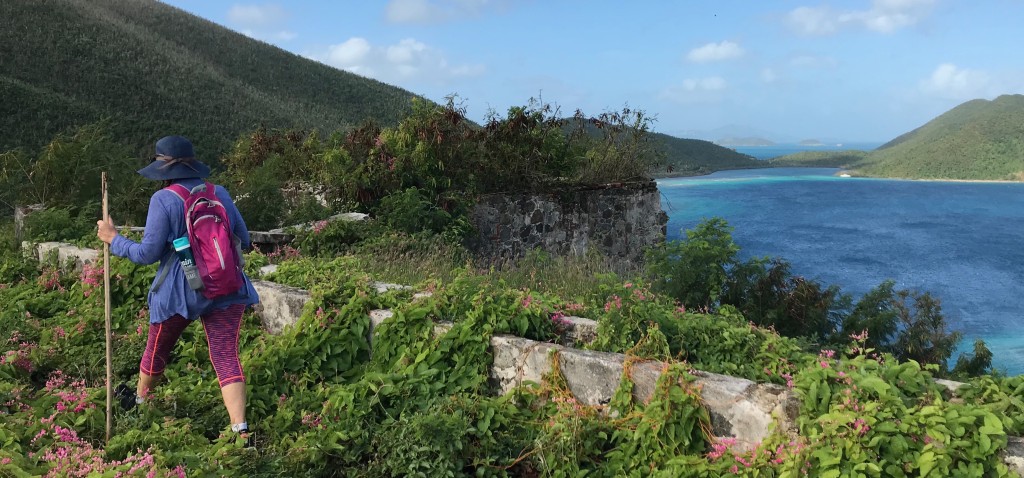
Hiking up the Johnny Horn Trail, the old views are changed, and there are new views where there used to be none. But it’s a glorious day and the views—old, new—are spectacular. Flowers are blooming, a vibrant pink. Butterflies are leading the way.
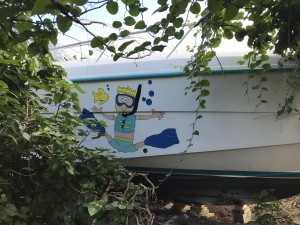
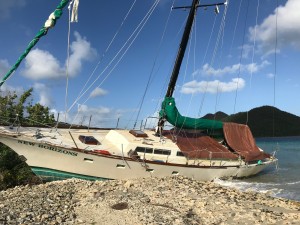
We stop at the ruins of the Murphy Great House, once home to a merchant and slave trader. A young woman in our group—a first-time visitor to St. John—had taken the National Park Service tour and recounts the history, fuzzy to the rest of us. The view is stunning. Waterlemon Cay and the Annaberg Sugar Plantation. Blue water and the BVIs.
We hike, higher, a bit steeper. A brief rain shower cools us off just as it was getting a little too hot. All the trails are hotter than normal, my friends say. There’s less shade now. But there’s bright green grass beneath our feet, and that’s something new.
Coming down the other side, the slope is muddy and slick from so much rain the previous few days. I pussyfoot through the slippery muck, claiming the view of Coral Bay as an excuse for my pathetic pace. From up here there’s a bird’s eye view of Emmaus Moravian Church, where on a normal Sunday morning you might hear the choir singing. But not today. The historic church—more than 200 years old—is silent, and vacant, its landmark red roof ripped from its body during Irma. The pastor and his wife—survivors—had been in the church when it began to blow apart.
Across the street from the church, in the ballfield-turned-trash-transfer station, mounds of metal, wood, and other debris are piled up. Remnants of people’s lives neatly towering in sorted heaps, waiting to be carted away. A travesty to use a recreation space, some say. A sign of progress, say others.
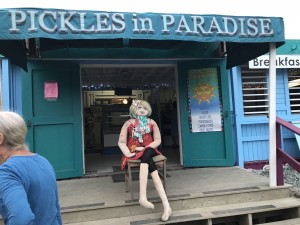
Down the road, a life-size stuffed doll sits on the porch of Pickles in Paradise, holding a martini glass. Her position changes every day, a happy, heartening gesture. The restaurant is newly opened, and brunch is being served. There are cheery tablecloths on the tables out back, and a musician plays saxophone as diners—tourists and locals—eat omelettes and stuffed French toast. The atmosphere is festive. I run into a friend who tells me, giddily, that her check is coming on Wednesday. It’s what she told me on my first trip down two months ago: My check is coming on Wednesday! It’s what the insurance company had been telling her for weeks, and now months.
It’s been over five months since the hurricanes. The weather is beautiful—it’s high season, after all. You’ve probably seen some lovely, almost normal, photos online, in Facebook posts and travel stories, all blue sky and green hillsides, crystalline water beckoning.
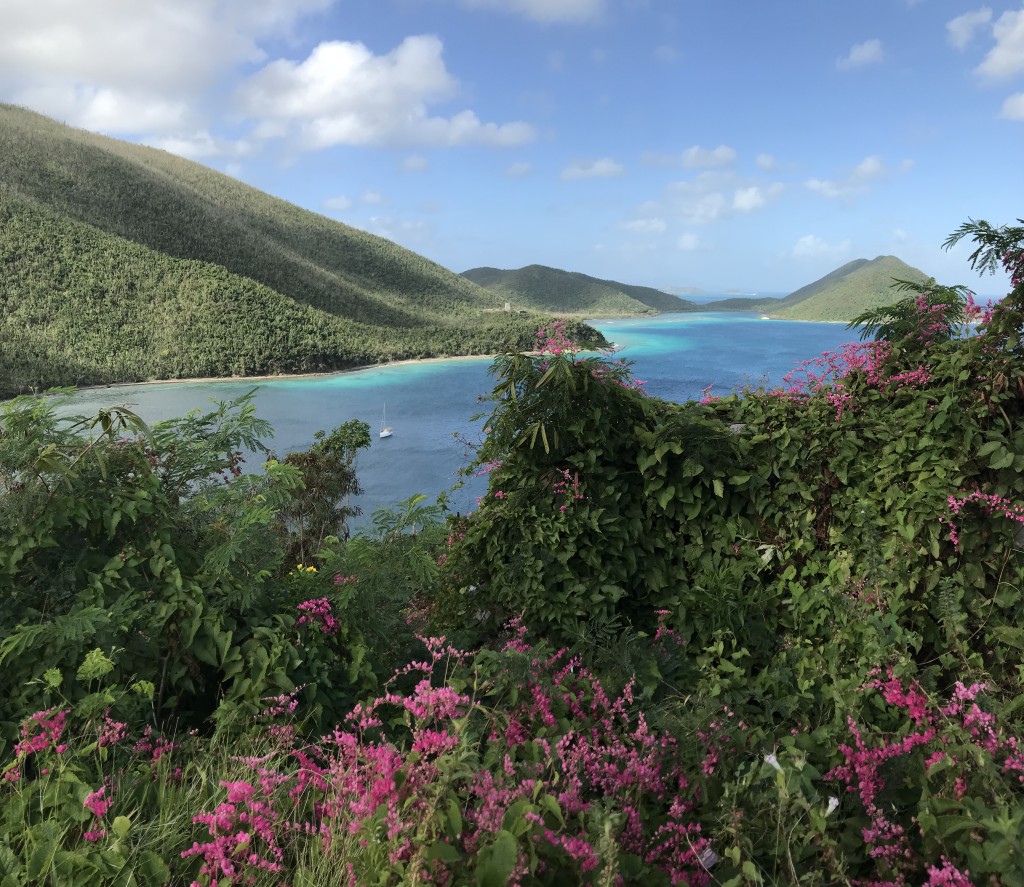
As the Caribbean recovers from the pummeling of Irma and Maria—two back-to-back Category 5 storms—these colorful images are a welcome sight. Tropical flowers in bloom. Boats on the water. A smattering of tourists on the beaches. After all those post-storm photos of the destruction and the despair and the brown, these new scenes are encouraging, hopeful, even necessary. They are also real, unfiltered. I know this because I’ve just seen it with my own eyes. But are they true?
While the island itself is rejuvenating, and fresh-faced recovery teams are working overtime to help rebuild, and even the residents—survivors all—are putting forth a brilliant display of optimism and resilience, St. John—like its sister islands—has suffered significant trauma. That tireless woman helping other victims? She is currently homeless. That tireless man, helping other victims? He’s separated from his kids, who are staying with relatives in the States. That family laughing while enjoying a free meal? They lost their boat, which was their home, and everything on it. That bubbly lady serving up the free meal? She hasn’t had power—or water—for five months. That smiling little girl has been doing her homework by flashlight. That grown man, almost in tears, what do you think his situation is to be reduced to such a public display? Oh, and the guy taking the photos? His house was blown away, too.
Social media has filled a vacuum in old-fashioned news coverage, with mixed results. Never was I so happy to be on Facebook as in the 72 hours after Irma clobbered a tiny place I used to call home. With traditional communication almost impossible, an extensive cyber community allowed hundreds of people to share information about who was safe. That was a godsend. In the days that followed, social media was an outstanding tool for those in a position to help to organize relief efforts.
Now, as is the trend in 2018, plundered islands put their best face forward online. It’s a stunning, beautiful face, but often without context. If you’re a resident of an island decimated by hurricanes last year, you’re living the context. It behooves the rest of us looking at the pretty beach picture to understand its fragility, and remember that scenes of devastation are just out of frame. It’s true the islands need tourists to come back to restore the economy. Businesses need vacationers to spend money. Locals need an influx of positive energy—and cash flow—to keep their spirits up. But it’s also true that Mother Nature, in such a fertile place, is recovering much more quickly than many who live among her blossoming trees, or beside her pristine waters. Sometimes a picture needs those thousand words.
***
On this, my second trip since the two hurricanes, I get an airport pickup from my friend who is spending the day on St. Thomas shopping. She managed to squeeze onto the car barge from St. John that morning, her vehicle wedged between a dozen or so garbage trucks, all hauling waste off the island. She needs to buy new furniture for the living room of the villa she manages. The first real renters—not the National Park workers who have been staying in the house since the lights came back on—are coming at the end of the week. The perimeter of the house is a construction site, with the laborers putting in decidedly not-normal 12-hour days. The entire deck around the pool still needs to be replaced and the tiles haven’t come in yet. The pressure is on.
I spend a week doing interviews with storm survivors. The mechanic who was sucked out of his house, clinging to a door handle, on the same piece of land where his grandfather was blown to his death in a hurricane in the ‘20s. The boat builder who was knocked unconscious and spent two hours, alone, lying outside on a balcony, bruised and bleeding, as the eye wall passed over, ripping her shirt to shreds. The waitress who jumped from a second-story window as her home collapsed around her and ran through howling wind and rain to a neighbor’s for safety. The sailor who thought he could ride it out on his boat and, when the boat started sinking, swam ashore and clung to a rock. I hear secondhand a story about a family huddling together on a sofa bed that, after their house blew apart, slid down a hillside with everyone on it, safe. It sounds apocryphal, at least exaggerated. But maybe not.
Five months after the hurricanes, many things are getting back to normal, but it’s still a mixed bag. Almost everyone has power, but some people just got it. Think about that: five months with no power. Those with money—able to pay for supplies and, more challenging, procure them—are rebuilding. Those who know how to build or fix or clean are working. Everyone, it seems, is waiting for checks—from FEMA, from other government agencies, from their insurance companies. Like my friend in Coral Bay, the one whose check is promised on Wednesday, they need cash to start rebuilding. But Wednesday comes and goes. Maybe next week.
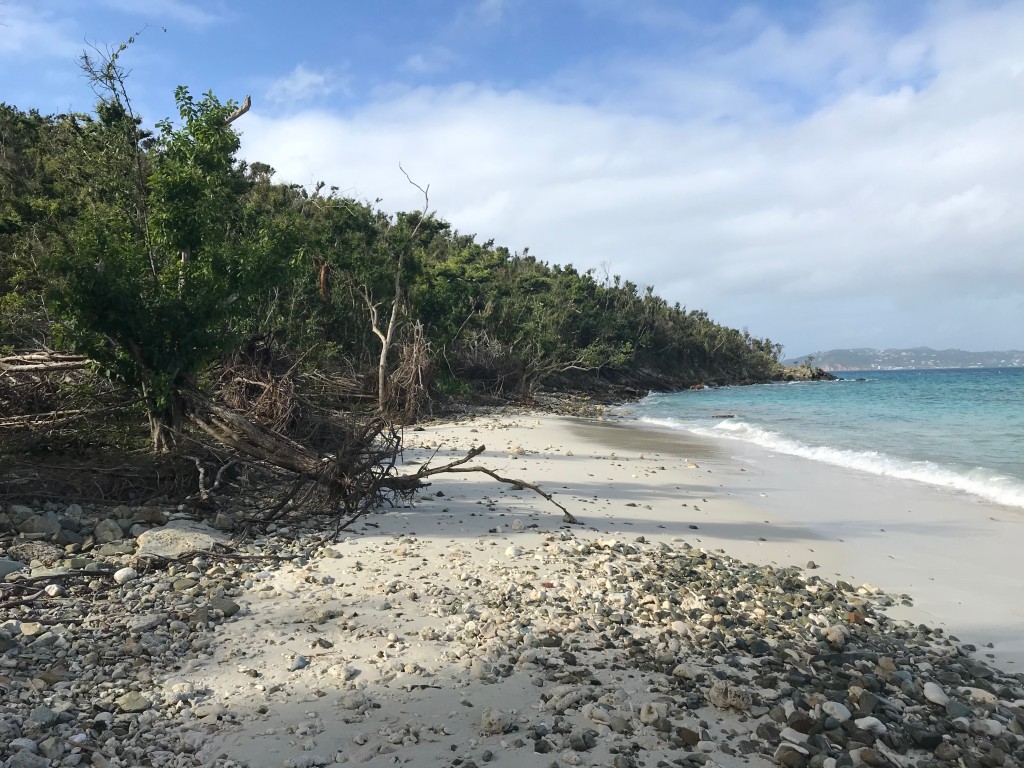
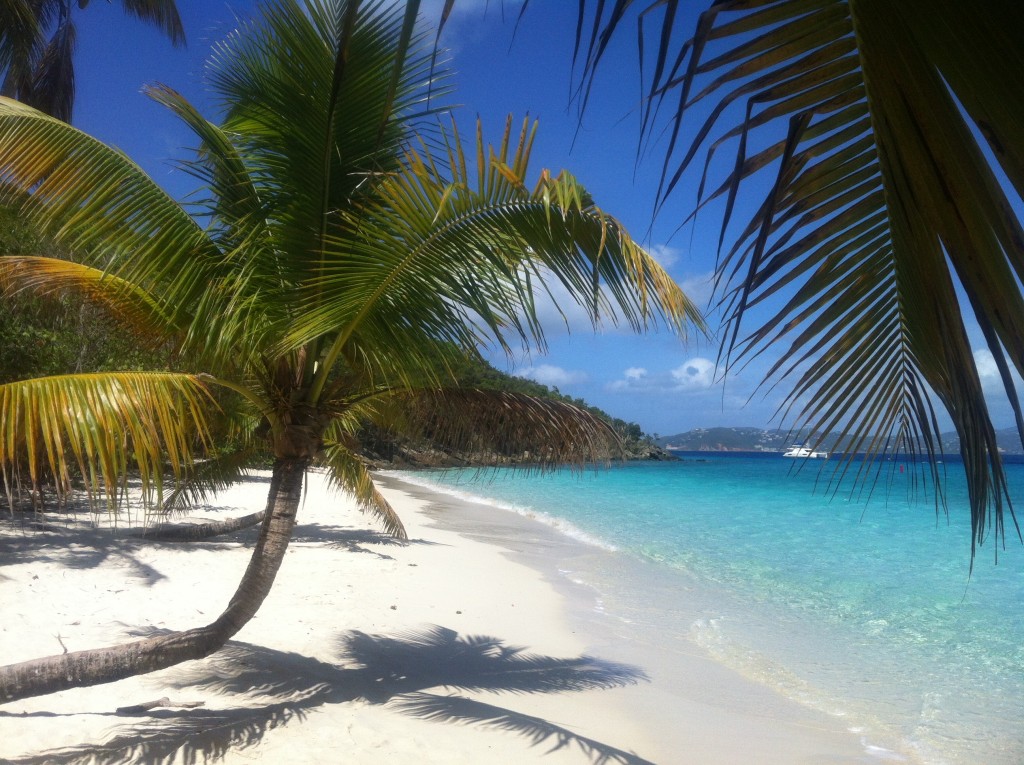
All of the National Park beaches and hiking trails are open. Tourists have returned, arriving on cruise ships or staying in villas that suffered minimal damage. The two big hotels are still closed, one indefinitely. You can go to the beach and have it all to yourself, but you have to bring your own shade, because the trees are gone. If you know St. John, the state of the beaches at Maho or Solomon will break your heart, but it’s beautiful if you look out. It’s always beautiful but this time of year—January, February, high season—it’s even more so, that impossibly blue sky, the air so clear. It’s windy the first few nights, cool and breezy, great sleeping weather, I would normally call it, but not for people who have been traumatized by wind. Some say the wind doesn’t bother them at all, but a heavy rain will keep them up at night. People openly talk about PTSD. A dear friend—a self-sufficient, strong island woman, I would call her—breaks down while describing trying to drive on eroded, battered roads. The roads were always precipitous, but now you can see just how steep, and precarious, some of those inclines and hairpin turns really are. She has fear now, she says through tears. She never had fear before.
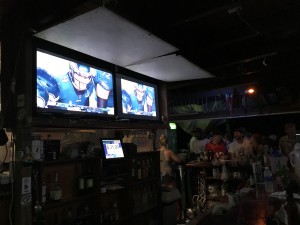
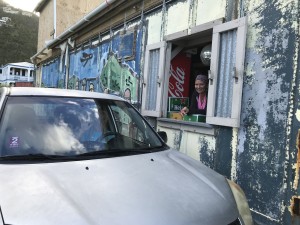
There are places to eat and drink. In Coral Bay, Skinny Legs is open again, and Pickles. So is Oasis with—at least on the day I was there—a drive-through. In Cruz Bay, Sun Dog and Tap Room have been humming along for months. There’s a new Mexican place in town called Greengos. Miss Lucy’s is getting ready, and Aquabistro…but Zozo’s is gone for good, and so is Shipwreck. A friend who lost her own restaurant business has been hired to run the kitchen of another. She’ll open soon with dishes, cups, and appliances salvaged from other shuttered restaurants.
St. John is not suffering from a humanitarian crisis on the scale of Puerto Rico, but working class people are struggling. There’s a severe housing shortage. A bartender friend and long-time resident is starting to face the fact that she may have to leave. She knows her boss is being fair, dividing the work evenly among the staff, but a shift or two a week won’t pay the bills. Plus it’s exhausting, she says, listening to the second home-owners who are coming down now, complaining about minor damage, or the frustrations indigenous to island building. Don’t they realize they may be talking to someone who is homeless, who literally lost almost everything she owned?
Not everyone is clueless. There are tourists who are trying to spend part, or all, of their vacation volunteering and part-time residents who are generous and compassionate. By some estimates, the island population is about half of what it was pre-storms, but people are returning every day. In one week I met three people who just moved down permanently—first-time, full-time residents. One is building a house, the others, a couple, refused to change their plans to retire on St. John, hurricanes be damned. Fresh blood is welcome. The overall feeling is optimistic. There are fewer people with that wild-eyed “look”. But progress is slow. The car barge is unreliable, and overcrowded. Phone service and internet are temperamental. Constant power is not a given. Whole days are wasted trying to get one thing done.

Yet things do get done. By the end of my short stay, the new furniture had been delivered to the rental villa overlooking Cruz Bay. The last tile got laid at the pool before the first guest arrived. My friend in Coral Bay got her insurance check. It didn’t come on Wednesday, but it did come on Friday. Private money is flowing to the island. On my last day there, former president Bill Clinton paid a visit, with a promise of funds from his foundation. It can’t come too soon. Hurricane season is just three months away.
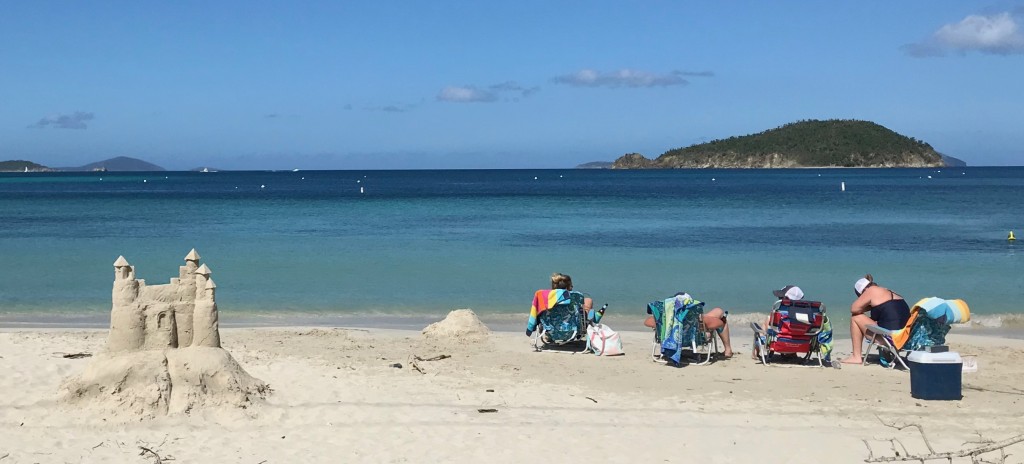

0 Comments on “Pretty Pictures (A Hurricane Update)”